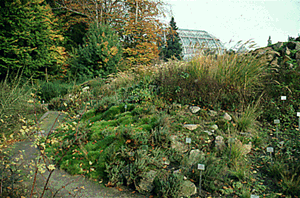 Part of the Plant geography section shows the vegetation of Europe.Besides bog and heath there are seven Central European forest types: Hornbeam forest, Beach forest, Oak forest, Mixed forest, Birch-Pine forest, Riparian forest and Mountain forest. The botanical wealth of the Alps is spread over three areas: northern limestone Alps, central primary rock Alps and southern limestone Alps. The various elevational stages, such as montane, subalpine and alpine, can be recognised. Additional displays show Jura, Central European low mountains and Scandinavia.A large area is dedicated to the Iberian Peninsula. Here two contrasting zoobiotic vegetations are placed side by side: the Tomillares on limestone, with Labiatae, and the Atlantic Heath on acid soil, with Ericaceae and Genisteae. A touch of three forest types can be seen: thermophilous bush with Abies pinsapo and Pinus pinaster, and Oak-Scots Pine forest and Birch-Corsican Pine-forest of acid soil. The mountain flora is represented in displays of the calcareous Pyrenees, the central Spanish primary rock mountains and the southern Spanish Xero-Acanthetum, with corresponding endemics.
Part of the Plant geography section shows the vegetation of Europe.Besides bog and heath there are seven Central European forest types: Hornbeam forest, Beach forest, Oak forest, Mixed forest, Birch-Pine forest, Riparian forest and Mountain forest. The botanical wealth of the Alps is spread over three areas: northern limestone Alps, central primary rock Alps and southern limestone Alps. The various elevational stages, such as montane, subalpine and alpine, can be recognised. Additional displays show Jura, Central European low mountains and Scandinavia.A large area is dedicated to the Iberian Peninsula. Here two contrasting zoobiotic vegetations are placed side by side: the Tomillares on limestone, with Labiatae, and the Atlantic Heath on acid soil, with Ericaceae and Genisteae. A touch of three forest types can be seen: thermophilous bush with Abies pinsapo and Pinus pinaster, and Oak-Scots Pine forest and Birch-Corsican Pine-forest of acid soil. The mountain flora is represented in displays of the calcareous Pyrenees, the central Spanish primary rock mountains and the southern Spanish Xero-Acanthetum, with corresponding endemics.
The Mediterranean aspect is continued via Southern Europe - with Abies nebrodensis - to the Balkan peninsula. Here the differences between the humid uplands (Aesculus, Ostrya) and the dry uplands (Abies cephalonica) can be seen. The alpine areas show various endemics and tertiary relics like Haberlea and Ramonda, and a patch of Xero-Acanthetum with Astracantha. Seasonal highlights are in spring, when many geophytes are in flower, and in summer, when the perennial herbs from the mountains are in colour.
Text: Werner Schwarz
The Little Tour ends here. Back to Main Map of the Garden.
